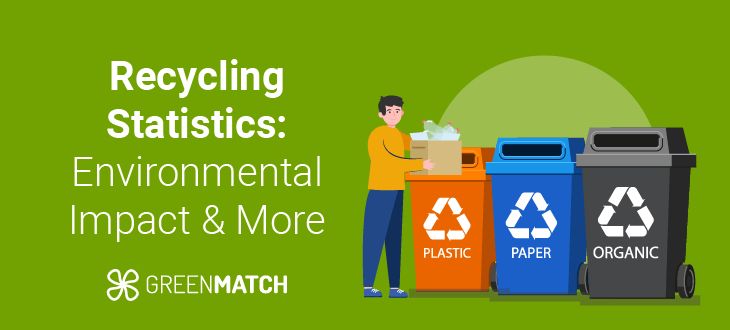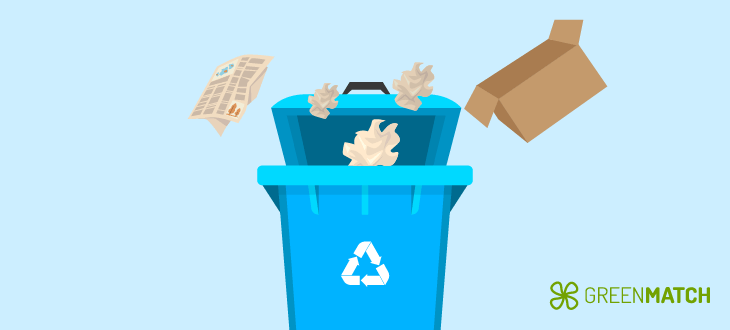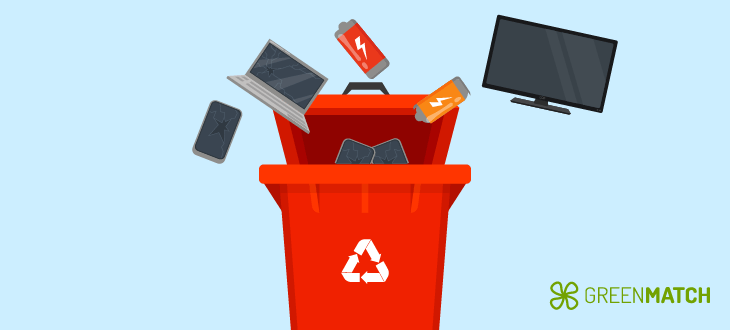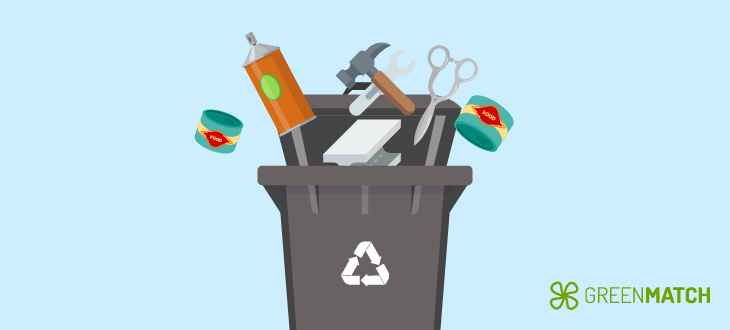- GreenMatch
- Blog
- Recycling Statistics
Recycling Statistics: Environmental Impact & More


- Recycling could prevent between 5.5 and 6.02 gigatons of carbon dioxide emissions between 2020 and 2050, the equivalent of removing over one billion cars from the road for a year.
- 100,000 tonnes of recyclable waste is rejected every year in the UK due to contamination.
- Only 9% of plastic waste and less than 25% of e-waste is recycled globally each year.
- Government incentives such as deposit return schemes are helping to promote more recycling.
The world produces 2.01 billion tonnes of waste a year, and this number is set to increase by 73% by 2050. Ineffective waste management, overconsumption and a lack of education are causing more people to discard their waste without considering its environmental impact. As a result of our growing waste problem, 20% of human-caused methane emissions stem from the waste industry, which is a major driver in rising global temperatures. These figures make it clear that the world is facing a major waste management crisis.
One of the easiest ways to help fight our growing waste problem is recycling. By giving old products a new lease of life, we can help reduce global emissions, save our precious limited resources and limit the amount of land used for landfills. But to truly understand the benefits of recycling, it is important we look at the data.
In this article, we will explore recycling statistics and facts surrounding different types of materials, the challenges it faces, and dive into what the future holds for the world of recycling.
What do we mean by recycling exactly?
Recycling is the action of collecting waste that would otherwise be thrown into landfill and processing it into new reusable products. Here are the basic steps of recycling:
- Collection and processing: Waste materials are collected from homes and businesses and are then sorted by type (plastic, metal, paper, etc).
- Cleaning and preparation: Materials are cleaned to remove food waste, adhesives, and other contaminants.
- Manufacturing: Clean products are broken down into raw forms such as pellets, pulp and metal sheets. These raw materials can then be created into new products such as clothing and packaging.
There are two main types of recycling: closed-loop and open-looped. According to a 2015 study, both of these methods use fewer resources than sending waste to landfills or burning it for energy.
- Closed-looped: Materials are recycled into the same product.
- Open-looped: Materials are transformed into a different product, i.e. plastic bottles turned into textiles.
When recycling, it is important to sort the materials into the right container. An estimated 100,000 tonnes of recyclable waste is rejected each year due to it being contaminated, according to the BBC.
Recycling is often confused with similar practices such as reusing, composting, or upcycling, but they play different roles.
| Recycling vs Reuse, Composting & Upcycling: What’s the Difference? | ||
|---|---|---|
| Term | Definition | Examples |
| Recycling | Processing waste into new materials | Turning plastic bottles into textiles |
| Reuse | Using an item again for a different purpose | Reusing glass jars for storage |
| Composting | Breaking down organic material into soil | Composting food waste |
| Upcycling | Repurposing waste into items of higher quality. | Making furniture from old wooden pallets |
Ultimately, recycling is part of the common phrase: reduce, reuse, recycle. And although recycling has been around since the Byzantine era, according to a 2018 study, recycling only really gained popularity in the 1970s.
The passing of the Resource Conservation and Recovery Act (1976) in the U.S. is considered a key player in propelling the popularity of recycling in the modern world. While, recycling is an essential tool to reduce waste, it has to be combined with human efforts in order to make a cleaner, greener future.
Environmental impact of recycling
Recycling offers a number of positive impacts to the environment. By turning what usually is landfill waste into usable materials, recycling reduces the need to extract and process raw materials. These activities are often seen as environmentally harmful as it requires an excessive amount of energy, water and chemicals, which can contribute to climate change.
On of the biggest benefits of recycling is the reduction of greenhouse gases. On average, recycling is estimated to reduce carbon dioxide by 700 million tonnes per year, according to the BBC. It not only limits the emissions by reducing the demand of raw materials, but recycled materials use less energy overall. For example, the U.S. Energy Information Administration states that recycled aluminium cans use 95% less energy than processing bauxite ore, the raw material aluminium is made from.
Recycling also helps preserve natural resources. According to the UN Environmental Programme, for every tonne of recycled paper, 17 trees have been saved, and the water used in manufacturing is cut by 50%. By choosing recycled paper, you can reduce deforestation, which accelerates climate change and destroys precious ecosystems.
Although recycling has many positive impacts on the environment, it is not without some issues. According to Politico, a worry within the recycling industry is that it may unintentionally promote overconsumption. If people believe that the products they buy are recyclable, it may make them feel less guilty for buying frequently, especially when it comes to products such as plastic bottles or aluminium coffee capsules.
The positive emotions associated with recycling can overpower the negative emotions associated with wasting” — Monic Sun and Remi Trudel, professors at Boston University
Key statistics and trends

- The world generates around 2.01 billion tonnes of waste every year, and is expected to increase by 73% by 2050.
- In low-income countries, materials that could be recycled accounted for only 20% of the waste produced.
- In the EU, the amount of waste sent to landfills decreased from 23% to 16% between 2010 and 2020.
- Recycling can reduce between 5.5 to 6.02 gigatons of carbon dioxide between 2020 to 2050.
- As of 2022, the global recycling market was valued at $58 billion, it is expected to increase to $90 billion by 2032.
- The recycling rate in the UK was 44.1% in 2022, which decreased from 44.6% in 2021.
- In the EU, the recycling rate is around 49%.
- The EU’s Extended Producer Responsibility policy has contributed to a 50% decrease in landfill waste.
- The 2020 EU circular economy action plan plans to half landfill waste by 2030.
- In 2024, the UK introduced a Deposit Return Scheme (DRS), where consumers pay a small deposit on plastic bottles and cans, refundable when returned. The scheme is expected to boost recycling rates for in-scope containers to over 90%.
- In 2015, the UK introduced a 5p charge on single-use plastic bags in 2015, leading to a 95% reduction in their use.
- Adopting a circular economy could add £23 billion to UK businesses a year and potentially create 700,000 jobs.
- China’s National Sword Policy, implemented in 2018, banned the importation of plastic and other recyclable materials, which resulted in over 100 million tonnes of plastic waste from other countries being displaced.
Food recycling statistics and facts

Food waste is a major issue worldwide. Not only does it contribute to climate change, but it also worsens food poverty throughout the world. When food is wasted, so too is the labour, land, water, and energy that is used during production.
By understanding food recycling statistics and facts, you can take the first step in reducing food waste. According to the WWF, educating consumers on food waste could prevent 7.41 million tonnes of greenhouse gas emissions:
- Around one-third of food produced globally is never eaten.
- 40% of food is lost or wasted along the value chain, from producer to consumer.
- On average, 40.8% of food is recycled globally every year.
- Food waste contributes to 8-10% of greenhouse gas emissions every year
- Food waste contributes to 58% of methane emissions within landfills.
- The global cost of food waste is around $1 trillion annually.
- The food currently wasted in Europe could feed up to 200 million people.
- If 25% of the food waste around the world was saved, it could feed up to 870 million people.
- In the UK, household food waste accounts for 60% of the total national food waste.
- China is one of the largest producers of food waste, with an estimated 109 million tonnes of food wasted in 2022.
- In the UK, household food waste accounts for 60% of the total national food waste.
- UN’s Sustainable Development Goals aim to halve food waste and loss by 2030.
Paper recycling statistics and facts

- The average global recycling rate of paper is around 59.9% as of 2021.
- Europe is the leader in paper recycling, with an average recycling rate of 70.5%.
- In 2023, the amount of recovered paper produced worldwide surpassed 232 million tonnes.
- Paper and cardboard packaging had the highest recycling rate for packaging in the European Union in 2022, at 83.2%.
- The EU’s Packaging and Packaging Waste Directive, aims to have about 85% of all paper packaging recycled by 2030.
- In 2023, 64.8% of UK packaging waste was recycled, increasing from 62.4% in 2022.
- Paper generates about 1.3% of global greenhouse gas emissions every year.
- Recycled paper uses 40% less energy compared to making paper from scratch.
- Recycling one tonne of paper can save up to 17 trees.
- Over a 30 year period, recycled paper can reduce greenhouse gas emissions by 2.28 to 2.90 gigatons of CO2.
- Although recycling paper has many benefits, a 2022 study in Nature Sustainability noted that if all paper was recycled, it could increase carbon emissions by 10% as recycling paper mills heavily rely on fossil fuel electricity.
Plastics recycling statistics and facts

- The world produces an estimated 460 million tonnes of plastic every year.
- About 400 million tonnes of plastic waste is produced annually.
- Global plastic waste is set to triple by 2060, according to the OECD.
- Only 9% of plastic waste is recycled every year.
- In the UK, only one-quarter of plastic is recycled every year.
- It is estimated that UK households throw away a staggering 90 billion pieces of plastic packaging a year, or 1.7 billion pieces a week
- Germany has the highest plastic recycling rate in the world at 65%.
- Chile recycles the least amount of plastic each year, with a recycling rate of just 1%.
- 49% of global plastic waste ends up in landfills, while an additional 19% is incinerated.
- Around 0.5% of plastic waste ends up in the ocean, currently, there is an estimated 171 trillion pieces of plastic in our oceans.
- Poorly managed plastic waste leads to microplastics contaminating water, food, and even the human body.
- It can take up to 450 years for plastic bottles to decompose and 500 years for plastic toothbrushes.
- Greenpeace has reported that recycled plastic bottles may contain a higher level of harmful chemicals compared to virgin plastic.
- According to the National Association for PET Container Resources, only 21% of plastic bottles collected are recycled.
- The EU aims to make all plastic packaging recyclable or reusable by 2030.
- The UN is working on Global Plastics Treaty to tackle plastic pollution worldwide.
- Recycling plastic waste significantly reduces carbon emissions by 42% compared to producing new plastic products.
Glass recycling statistics and facts

- Around 130 million tonnes of glass is produced each year.
- Around 27 million tonnes of glass is recycled worldwide every year.
- The global glass recycling rate is around 21%.
- As of 2023, the UK achieved a glass recycling rate of 69.8%.
- Sweden is the top country for recycling glass, with a recycling rate of 95%.
- Glass can be recycled forever without losing any of its quality.
- Using recycled glass can help reduce air pollution by 20% and water pollution by 50%, according to WWF.
- 40% less energy is needed to make recycled glass compared to producing new glass.
- Producing new glass can produce 95 million tonnes of CO2 worldwide annually.
- One tonne of recycled glass can save 590kg of sand, 185kg of soda ash, and 172kg of limestone, according to Business Waste.
- It can take up to 4,000 years for a single glass bottle to decompose.
- The global glass recycling market is valued at $3.3 billion as of 2024 and is expected to reach $5.6 billion by 2033, according to Custom Market Insights.
E-Waste recycling statistics and facts

- E-waste is discarded electronic appliances such as mobile phones, laptops, and TVs.
- Electronic waste is the fastest growing waste stream worldwide, with a growth rate of 3 to 5% annually.
- In 2022, the world produced 62 million tonnes of e-waste.
- Less than a quarter of e-waste waste is recycled, according to the World Health Organisation.
- 85% of e-waste is sent to landfills or incinerated, releasing harmful toxins into the atmosphere.
- Electronic waste is more complicated to recycle than other materials and requires disassembling the products to remove harmful chemicals and then shredded.
- Many electronics contain harmful chemicals, such as lead, mercury, and cadmium.
- Only 10 out of 60 chemicals present in e-waste can be recycled.
- The raw material value of global e-waste was estimated at $57 billion, much of it lost due to improper recycling.
- Poorly managed e-waste can pose serious health risks, such as respiratory issues, an increased risk of disease and can disrupt neurological and behavioural development in children.
- China produces the most amount of e-waste, generating around 12 million tonnes in 2022, followed by the United States, generating 7 million tonnes.
- Europe has the highest recycling rate of e-waste, at 42.8%.
- Estonia is the number one country in recycling electronic waste, at a recycling rate of 76%.
- The European Union's Waste Electrical and Electronic Equipment (WEEE) mandates proper collection and recycling of e-waste, aiming to reduce environmental impact.
- As of 2020, the electronic recycling market was valued at $49,880 million.
- Urban mining is emerging as a leader in recovering precious metals from e-waste, which may help reduce the reliance on virgin mining and promote circular economies.
Aluminium recycling statistics and facts

- Aluminium is one of the most sustainable materials as it can be recycled over and over again without losing its quality.
- 75% of aluminium ever produced is still being used today, thanks to recycling.
- The global recycling rate of aluminium is 76%.
- Recycling aluminium saves 95% of the energy required to produce the same aluminium from its virgin source, bauxite.
- Austria and Wales have the highest recycling rates of aluminium, at 59%.
- One tonne of recycled aluminium saves over 16 tonnes of greenhouse gas emissions, which is equivalent to driving over 400,000 miles.
- According to PR Newswire, recycling aluminium cans could potentially create 104,000 jobs and generating an estimated $1.6 billion in economic activity.
Textile recycling statistics and facts

- 1.92 million tonnes of textile waste is produced every year, according to Earth.Org.
- UK households throw away around 1 million tonnes of textiles each year.
- More than 65% of new clothes produced end up in landfills within the first 12 months.
- Textiles can take up to 200 years to decompose.
- Only 1% of clothing produced is recycled.
- Only 0.3% of materials used in the textile industry come from recycled sources.
- Germany has the highest recycling rate for textiles, at 71.1%.
- The textile industry is responsible for 8 to 10% of greenhouse gas emissions.
- The textile industry’s greenhouse gas emissions are expected to increase by 50% by 2030.
- According to the European Environment Agency, buying textiles generates around 270kg of CO2 per person.
- Textile production is estimated to be responsible for 20% of clean water pollution.
- The textile industry is responsible for about 9% of microplastics entering the oceans every year.
- $500 billion is lost every year in the textile industry due to poor recycling practices.
- The market for second hand textiles is valued at $256 billion and is expected to increase by $100 billion in the next 4 years.
- As of 2024, an estimated 65% of shoppers are now buying second hand textiles, including clothing, accessories and shoes.
- Due to fast fashion, clothing is only worn between 7 to 10 times, this has declined by 36% in the last 15 years.
- The EU Strategy for Sustainable and Circular Textiles aims to ensure that by 2030, all textiles are durable, repairable and recyclable to limit the damage of the textile industry.
Metal recycling statistics and facts

- About 400 million tonnes of metal waste is recycled every year.
- The global scrap metal market is valued at an estimated $407.2 billion in 2023 and is expected to increase to $568.76 by 2024, according to Fortune Business.
- In the UK, the scrap metal industry generated £6.2 billion between the years of 2022 and 2023.
- The United States is the largest exporter of scrap metal, with over 16 million tonnes of scrap metal being exported every year.
- Only half of all metals in the UK are recycled.
- 44% of EU copper demand comes from recycled sources.
- 70% of steel produced is still used today.
- Metal recycling saves up to 20 times more energy compared to extracting raw metals.
- Using recycled metals can reduce air pollution by 80%, water pollution by 76%, and water use by 40% compared to virgin metals.
- Using recycled steel reduces CO2 emissions by 58%
- Using copper scraps can reduce carbon emissions by 65%.
Which countries are the best at recycling?
Over the last 20 years, recycling has seen massive growth worldwide. Countries within the European Union, the UK, China and India have become leaders in recycling. According to OurWorldData, recycling rates increased by 12 to 13%.
While many countries are using recycling to lower their carbon footprint and reduce the acceleration of climate change, many see the economic benefits of recycling. According to the EPA, recycling in the United States provided 681,000 jobs, $3.7 billion in wages, and $5.5 in tax revenues.
However, while we look at the data that shows the top recycling countries, it is important to note that many rich countries have historically been sending their waste to other countries. Countries in the European Union as well as the United States, are the largest exporters of recyclable waste, according to the BBC. This practice can make recycling rates in these countries appear to be higher while shifting the environmental burden onto poorer countries like the Philippines, Taiwan and Vietnam.
For instance, Germany is considered one of the best countries for recycling but exports an average of 1 million tonnes of plastic waste a year, according to the Guardian. In many of these poorer countries, waste infrastructure and recycling systems are less developed, leading to lower recycling rates and causing greater environmental harm.
Top five recycling countries as of 2025
| Ranking | Country | Recycling rate |
|---|---|---|
| 1 | Austria | 59% |
| 2 | Wales | 59% |
| 3 | Taiwan | 53% |
| 4 | Germany | 52% |
| 5 | Belgium | 52% |
Note: This data is from the latest study by Reloop and Eunomia Research and Consulting.
The five lowest recycling countries in 2025
| Ranking | Country | Recycling rate |
|---|---|---|
| 1 | Chile | Less than 1% |
| 2 | Mexico | 5% |
| 3 | Turkey | 12% |
| 4 | Greece | 16% |
| 5 | Israel | 19% |
Challenges and limitations

Although recycling statistics show its many benefits, it is not without its challenges. Understanding these limitations can help shift our view and improve how we approach recycling, making the system more efficient and sustainable. Here are some key issues facing recycling today:
- Lack of education: Many consumers still remain in the dark on what can and cannot be recycled or how poor recycling habits can cause useable materials to end up in landfills. By striving to educate more people, we could see an increase in recycling rates.
- Safety concerns: Workers in the recycling industry can be faced with exposure to harmful chemicals and other safety hazards. A lack of safety regulations can make these jobs less appealing, leading to labour shortages.
- Exporting waste: Many wealthy countries export their waste. While this helps these countries meet their recycling goals, it does not improve waste management and only shifts the environmental burden elsewhere, which does not help slow down the rate of climate change.
- Material degradation: While metals and glass can be recycled almost endlessly, other materials like plastic can degrade over time, meaning the quality and usefulness is reduced each time it is recycled.
- Greenwashing: Many products claim to be recyclable but are not. This can allow consumers to buy products guilt free, unknowingly contributing to more landfill waste.
- Economic costs: Despite an increase in the use of recycled materials, many producers will opt for virgin materials if costs are lower. The cost difference remains a major barrier to expanding the use of recycled content.
While recycling is essential, these challenges show that it is not enough. Shifting our behaviour, reducing overconsumption and building more reliant and useful waste management systems along with recycling can help our world become more sustainable.
Future directions
Recycling is an important part of a greener and more sustainable future. However, it is not enough to help limit the amount of carbon emission we are creating each year. If we are looking to help prevent further damage, there is more we need to do, and improving our recycling approach is one of them.
AI and automation are playing a leading role in the recycling industry. According to Recycling Product News, AI systems such as TOMRA's GAINnext are learning to sort complex materials, including opaque plastics, which will avoid and limit contamination. Alongside this development, some companies are looking at enzymatic recycling, which creates enzymes to break down materials such as plastic and nylon, which could enable the production of new products without material degradation.
On top of technological advancements, governments worldwide are looking to push for better recycling practices. The European Union’s Packaging and Packaging Waste Regulation aims to make all packaging recyclable by 2030. In France, Anti-Waste and Circular Law is working to end the use of single plastic by 2040. And here in the UK, the government aims to introduce the Deposit Return Scheme by 2027, which will encourage consumers to recycle their plastic bottles.
While there are some challenges still facing recycling, these innovations, policy changes as well as consumer awareness can help drive the future of recycling in the right direction.
FAQ
Recycling is the process of collecting waste that would otherwise end up in landfills and converting them into new, useable products.
Commonly recycled materials include paper, glass, certain plastics, food waste, textiles, electronics and metals.
Recycling reduces the reliance of raw materials which cuts down greenhouse gas emissions, and helps conserve water, energy, and natural resources.
The biggest problems that face recycling today are contamination, exporting waste to poorer countries, misleading greenwashing and material degradation.

Caoimhe is an experienced content writer and researcher who is passionate about providing accessible information to every reader. With a background in English literature and Sociology, she combines the two disciplines to create cohesive, well-thought-out, and well-informed pieces.
We strive to connect our customers with the right product and supplier. Would you like to be part of GreenMatch?

